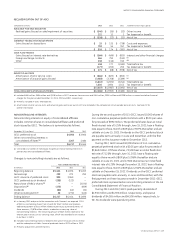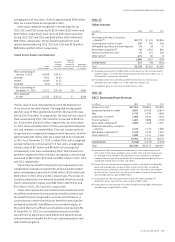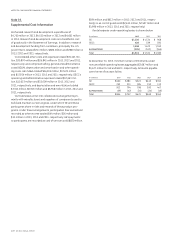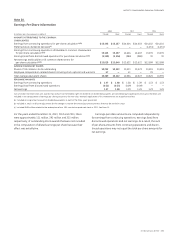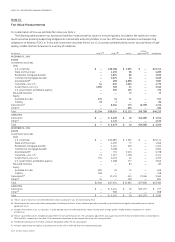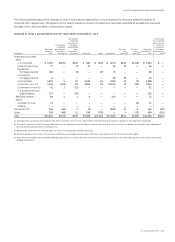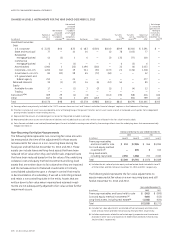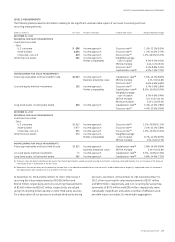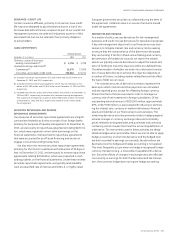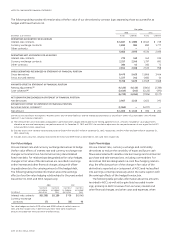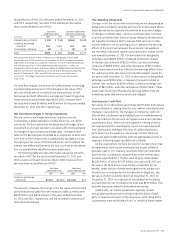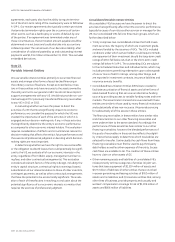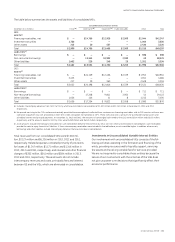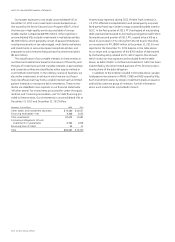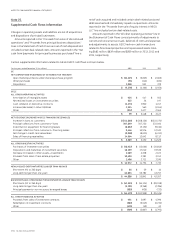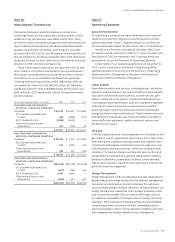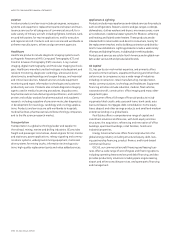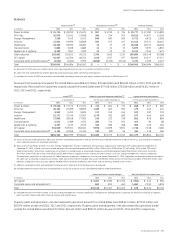GE 2013 Annual Report Download - page 129
Download and view the complete annual report
Please find page 129 of the 2013 GE annual report below. You can navigate through the pages in the report by either clicking on the pages listed below, or by using the keyword search tool below to find specific information within the annual report.
GE 2013 ANNUAL REPORT 127
INSURANCE—CREDIT LIFE
Certain insurance affi liates, primarily in Consumer, issue credit
life insurance designed to pay the balance due on a loan if the
borrower dies before the loan is repaid. As part of our overall risk
management process, we cede to third parties a portion of this
associated risk, but are not relieved of our primary obligation
to policyholders.
LOAN COMMITMENTS
Notional amount
December 31 (In millions) 2013 2012
Ordinary course of business
lending commitments (a) $ 4,756 $ 3,708
Unused revolving credit lines (b)
Commercial (c) 16,570 17,929
Consumer—principally credit cards 290,662 271,211
(a) Excluded investment commitments of $1,395 million and $1,276 million as of
December 31, 2013 and 2012, respectively.
(b) Excluded inventory financing arrangements, which may be withdrawn at our
option, of $13,502 million and $12,813 million as of December 31, 2013 and 2012,
respectively.
(c) Included commitments of $11,629 million and $12,923 million as of December 31,
2013 and 2012, respectively, associated with secured financing arrangements
that could have increased to a maximum of $14,590 million and $15,731 million
at December 31, 2013 and 2012, respectively, based on asset volume under
the arrangement.
SECURITIES REPURCHASE AND REVERSE
REPURCHASE ARRANGEMENTS
Our issuances of securities repurchase agreements are insignifi -
cant and are limited to activities at certain of our foreign banks
primarily for purposes of liquidity management. At December 31,
2013, we were party to repurchase agreements totaling $126 mil-
lion, which were reported in short-term borrowings on the
fi nancial statements. We have had no repurchase agreements
that were accounted for as off-book fi nancing and we do not
engage in securities lending transactions.
We also enter into reverse securities repurchase agreements
primarily for short-term investment with maturities of 90 days or
less. At December 31, 2013, we were party to reverse repurchase
agreements totaling $20.8 billion, which were reported in cash
and equivalents on the fi nancial statements. Under these reverse
securities repurchase agreements, we typically lend available
cash at a specifi ed rate of interest and hold U.S. or highly-rated
European government securities as collateral during the term of
the agreement. Collateral value is in excess of amounts loaned
under the agreements.
DERIVATIVES AND HEDGING
As a matter of policy, we use derivatives for risk management
purposes, and we do not use derivatives for speculative purposes.
A key risk management objective for our fi nancial services busi-
nesses is to mitigate interest rate and currency risk by seeking
to ensure that the characteristics of the debt match the assets
they are funding. If the form (fi xed versus fl oating) and currency
denomination of the debt we issue do not match the related
assets, we typically execute derivatives to adjust the nature and
tenor of funding to meet this objective within pre-defi ned limits.
The determination of whether we enter into a derivative transac-
tion or issue debt directly to achieve this objective depends on
a number of factors, including market-related factors that affect
the type of debt we can issue.
The notional amounts of derivative contracts represent the
basis upon which interest and other payments are calculated
and are reported gross, except for offsetting foreign currency
forward contracts that are executed in order to manage our
currency risk of net investment in foreign subsidiaries. Of the
outstanding notional amount of $320,000 million, approximately
87%, or $277,000 million, is associated with reducing or eliminat-
ing the interest rate, currency or market risk between fi nancial
assets and liabilities in our fi nancial services businesses. The
remaining derivative activities primarily relate to hedging against
adverse changes in currency exchange rates and commodity
prices related to anticipated sales and purchases and contracts
containing certain clauses that meet the accounting defi nition of
a derivative. The instruments used in these activities are desig-
nated as hedges when practicable. When we are not able to apply
hedge accounting, or when the derivative and the hedged item
are both recorded in earnings concurrently, the derivatives are
deemed economic hedges and hedge accounting is not applied.
This most frequently occurs when we hedge a recognized foreign
currency transaction (e.g., a receivable or payable) with a deriva-
tive. Since the effects of changes in exchange rates are refl ected
concurrently in earnings for both the derivative and the transac-
tion, the economic hedge does not require hedge accounting.


